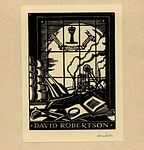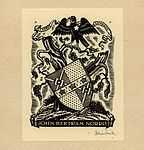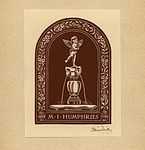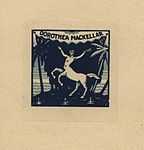Adrian Feint
| Adrian Feint | |
|---|---|
 Portrait of Adrian Feint by Max Dupain (1939) | |
| Born |
June 28, 1894 Narrandera, NSW |
| Died | April 21, 1971 (aged 76) |
| Nationality | Australian |
| Known for | Artist, designer, illustrator |
| Notable work | Bookplates |
Adrian Feint (28 June 1894 – 25 April 1971) was an Australian artist born in Narrandera, New South Wales. He worked in various media, but is noted for his bookplate designs.[1]
Education and military service
Feint studied at Sydney Art School from 1911 under Julian Ashton and Elioth Gruner. In 1916, Feint enlisted with the Australian Imperial Forces, and was sent to France with the 15th Field Ambulance. Before being demobbed in 1919, he was granted three months leave to study at the Académie Julien in Paris. He studied plate etching from 1922 to 1926; woodblock-engraving from 1926 to 1928, with assistance from Thea Proctor in 1927; and oil painting beginning in 1938, with Margaret Preston.
Artwork

He was co-director (with bookbinder Wal Taylor) and manager of Grosvenor Gallery, Sydney, from 1924–28. Exhibitors included the now-famous Thea Proctor, Elioth Gruner, Margaret Preston, Roland Wakelin, Roy de Maistre and G W Lambert.[2]
He was employed as assistant editor (to Sydney Ure Smith) of Art in Australia from 1928–40, contributing many cover illustrations to this and filling many commissions for his advertising agency Smith and Julius. Between 1927 and 1939, Feint made 18 covers for Ure Smith's magazine The Home, including the famous illustration on the October 1928 issue in collaboration with Hera Roberts.[3]
He abandoned graphic arts around 1939 (he reworked one bookplate in 1944) to work as a bookbinder with Benjamin Waite[2] and to illustrate limited edition books. After World War II he took up flower painting in watercolours, then oil-painting, but without critical acclaim in this last medium.
Bookplates
Feint's bookplates are his greatest legacy. Thea Proctor,[4] Dorothea Mackellar, Ethel Turner, Ethel Curlewis,[5] John Lane Mullins, Frank Clune, Peter Tansey[6] and the Duke and Duchess of York were among those who commissioned personal ex libris plates. In 1930 his bookplate designs were recognised by an exhibition at the Division of Fine Arts, Library of Congress, Washington US (organised by the American Society of Bookplate Collectors and Designers), and in 1933 were highlights of the first International Exhibition of Bookplates held in Sydney. They are prized by collectors such as members of the American Society of Bookplate Collectors and Designers[7] and the New Australian Bookplate Collectors Society.[2] According to the checklist compiled by Thelma Clune, he produced 221 commissioned bookplates.[2] Apart from Norman Lindsay, the only other Australian artist whose bookplates command anywhere the same interest is G D Perrottet.[8]
- Bookplates by Adrian Feint
-

"Tony's Book"
-

David Robertson
-

Bertram Norris
-

M. I. Humphries
-

Dorothea MacKellar
Awards and memberships
Feint was elected to the Society of Artists, and was a member of the Australian Painter-Etchers Society.
Awards
- Bookplate Association International first prize 1930 for Raoul Lempriere bookplate[2]
- John Lane Mullins woodcut prize 1933
- George FitzPatrick 'Typical Australian woodcut' prize 1933[9]
- His portrait, by Nora Heysen, hangs in the National Library, Canberra.[1]
Additional reading
- The Flower Paintings of Adrian Feint Ure Smith, 1948
- Adrian Feint and His Bookplates John Gartner, Hawthorn Press, Melbourne 1940
- A Fine Line G Caban, 1983
- Art and Australia vol 9 no 2, 1971
- Encyclopedia of Australian Art Alan McCulloch, Hutchinson, London 1968
References
- ↑ 1.0 1.1 http://adbonline.anu.edu.au/biogs/A140155b.htm
- ↑ 2.0 2.1 2.2 2.3 2.4 http://www.stoplaughing.com.au/bookplatesociety/images/stories/Bookplate%20Content/tnabs_newsletter%20no08_web.pdf
- ↑ Deborah Edwards, Denise Mimmocchi, ed. (2013). Sydney Moderns – Art for a New World. Sydney: Art Gallery of New South Wales. p. 110. ISBN 9781741740905.
- ↑ http://cs.nga.gov.au/Detail.cfm?IRN=102436
- ↑ http://cs.nga.gov.au/Detail.cfm?IRN=112338
- ↑ http://nla.gov.au/nla.pic-vn3916238
- ↑ https://www.facebook.com/album.php?aid=154548&id=51076258184&ref=mf
- ↑ http://www.theaustralian.com.au/business/wealth/telling-a-book-by-its-inside-cover/story-e6frgac6-1111113127290
- ↑ http://www.evabreuerartdealer.com.au/feint.html
External links
 Media related to Bookplates by Adrian Feint at Wikimedia Commons
Media related to Bookplates by Adrian Feint at Wikimedia Commons- Bookplates by Adrian Feint in the University of Delaware Library's William Augustus Brewer Bookplate Collection
|